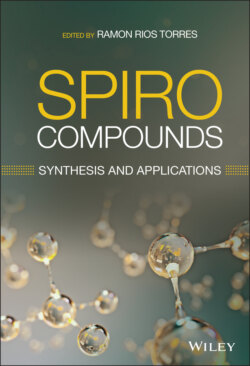Читать книгу Spiro Compounds - Группа авторов - Страница 29
3.3.3 Organocatalytic [4+3] and [2+2] Cycloaddition and Switchable Strategies to Construct Spirocompounds
ОглавлениеVery recently, the group of Fu and Huang developed an NHC‐enabled formal [4+3] annulation of flexible oxotryptamines 223 with enals 224 under mild reaction conditions (Scheme 3.21) [33]. A diverse set of enantioenriched seven‐membered heterocycles attached to spiro‐ε‐lactam oxindoles 225 was obtained with excellent enantioselectivities (90–>99% ee), and moderate to good diastereomeric ratios (3.2 : 1 to 13 : 1 dr). The aminoindanol‐derived triazolium pre‐catalyst 226 in the presence of DMAP and the oxidant 227 revealed the optimal catalytic system for the transformation. Different oxotryptamine derivatives and enals were successfully used as reaction substrates (22 examples) including a β‐alkyl enal, although in the latter case, the corresponding product 235 was obtained in lower yield and diastereoselectivity maintaining excellent asymmetric induction.
Scheme 3.20 Enantioselective Diels–Alder cyclization for the synthesis of carbazolespirooxindoles.
Source: Modified from Ren et al. [32].
In 2015, Jørgensen and coworkers reported an elegant catalytic methodology for the synthesis of biologically relevant complex spirocyclobutaneoxindole derivatives 236 (Scheme 3.22) [34]. The chemistry is based on the organocatalytic enamine‐based activation of cyclopropanes 237, forming a reactive donor–acceptor cyclopropane intermediate that in the presence of 3‐alkylidene oxindoles 238 promotes the formal [2+2] cycloaddition reaction to construct the spiranic products 236 in good yields, high diastereomeric ratios, and excellent enantiomeric excesses (15 examples, 3.2 : 1–>25 : 1 dr,70–97% ee). In fact, the reaction outcome is surprising since the traditional Lewis acid activation of donor–acceptor cyclopropanes typically promotes the [3+2]‐cycloaddition pathway. After mechanistic studies, the authors propose two possible reaction mechanisms for the spirocyclobutaneoxindole formation. The first plausible mechanism involves the organocatalytic activation of the cyclopropyl functionality leading to the formation of the iminium‐ion intermediate 239 by ring opening. From this intermediate, the dienamine 240 can be formed by deprotonation. Then, this dienamine intermediate reacts in a formal [2+2]‐cycloaddition with the 3‐olefinic oxindole 238 to form the spirocyclobutaneoxindole product 236. An alternative mechanistic possibility considers an initial [3+2]‐cycloaddition between the 3‐alkylidene oxindole and the organocatalytically activated cyclopropane, followed by a ring‐contracting rearrangement. However, the lack of a rational driving force for this rearrangement makes the latter reaction pathway more unlike.
Scheme 3.21 NHC‐catalyzed [4+3] annulation of oxotryptamines with enals to access enantioenriched spiro‐ϵ‐lactam oxindoles.
Source: Modified from Liu et al. [33].
Scheme 3.22 Organocatalytic enamine‐activation of cyclopropanes for highly stereoselective formation of spiranic cyclobutanes.
Source: Modified from Halskov et al. [34].
The development of switchable intermolecular reactions that afford divergent reaction pathways is an attractive and powerful strategy to build up structural and stereogenic diversity in drug discovery. In this context, Ouyang, Chen, and coworkers reported an aminocatalytic divergent cycloaddition toward the formation of two different types of spirocompounds 249 and 250 using the same set of substrates (Scheme 3.23) [35]. By simply changing the cocatalyst, the reaction pathway is switched from trienamine to dienamine activation mode. On the one hand, the in situ‐generated 4‐aminofulvenes act as 6π partners in the γ,β´‐regioselective [6+2] cycloaddition with activated 2π alkenes under the catalysis of 252 or 253 and salicylic acid 254. On the other hand, the α,γ‐regioselective [4+2] cycloaddition reaction is promoted with the catalytic system 255/2‐mercaptobenzoic acid 256. In the latter case, the β′‐regioselective sulfur addition of thiol 256 to 251 gives access to the enone 257 that after condensation with the chiral amine forms the 4π dienamine component in the reaction with activated alkenes. The [6+2] cycloaddition reaction mode provides fused bicycles linked to a pyrrolidinone ring 250 with five contiguous stereogenic centers (28 examples) while the [4+2] pathway affords spiro‐bridged cyclic scaffold 249 (22 examples).
Scheme 3.23 Chiral primary amine‐catalyzed regiodivergent asymmetric cycloadditions.
Source: Modified from Zhou et al. [35].
